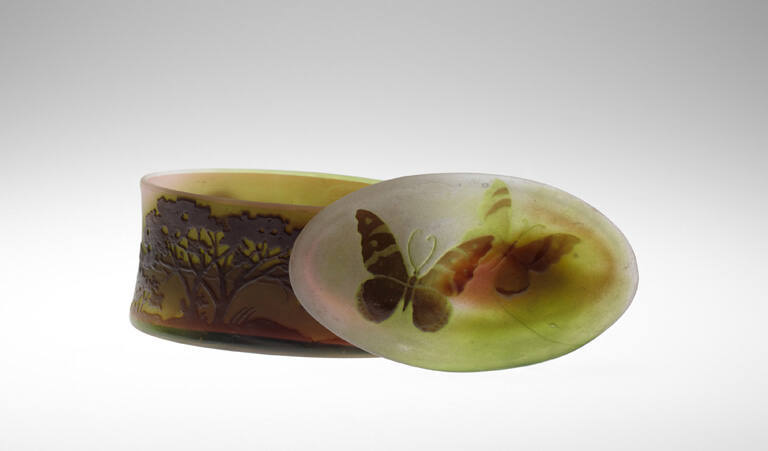

Object Details
Artist
Emile Gallé
Date
after 1889
Medium
Glass
Dimensions
2 1/2 × 5 1/4 inches (6.4 × 13.3 cm)
Credit Line
Bequest of Robert Kimberly Von Ruess-Chenberg
Object
Number
73.059.046
BRIEF DESCRIPTIONÉmile Gallé designed this box made of pale green acid etched cameo glass.WHERE WA(…)
BRIEF DESCRIPTIONÉmile Gallé designed this box made of pale green acid etched cameo glass.WHERE WAS IT MADE?This box was made in France.WHO WAS THE ARTIST?Émile Gallé (1846-1904) was a French glassmaker, ceramicist, and furniture maker. Gallé studied botany and mineralogy in Germany early on in his life, before he began glassmaking in Nancy in 1874. His work in glass reflects a lifelong fascination with these subjects, as well as his interests in the art of Japan and Symbolism. He first exhibited furniture at the Paris Universal Exposition in 1889 and rapidly expanded his business in the 1890s. He was awarded the Légion d’Honneur in 1900, confirming his status as an entrepreneur and unrivaled creator of French decorative arts. In 1901 he helped established the École de Nancy. The firm continued until the 1930s, even after his death.To see other glass items in the Johnson Museum’s collection designed by Gallé, search for object numbers 61.022 and 2001.075.004 in the keyword search box.HOW WAS IT MADE?Cameo glass is glass that is made from one color that has been covered by a second or even third layer of contrasting color(s), also called casing, flashing or overlaying. The outer layer is then acid-etched, carved, or engraved, producing a design that stands out from the surface of the vessel. Cameo glass dates back to ancient Roman times. It became popular in England in the 19th century when modern technology and methods eased cameo glass production.The designs on this box were created by an acid-etching technique. Acid etching was introduced into Gallé’s factory in 1889. The technique was developed in the 19th century to give glass a satin, matte finish by exposing it to hydrofluoric acid. Areas that were not to be etched were covered in a resist of wax, varnish, or oil into which the design was scratched before acid was applied.WHY DOES IT LOOK LIKE THIS?Notice the landscape scene on the body of the box and two butterflies on the lid. The scene depicts everything in silhouette. Gallé infused the objects he created with dream-like colors and settings. He was not only interested in nature, but also held the belief that objects could affect one’s thinking and “create an atmosphere of tranquility…to calm our nerves.”The decoration on this box is typical of Gallé’s Art Nouveau style objects. Art Nouveau, French for “New Art,” refers to an artistic style that was developed in Europe in the 1880s, and remained enormously popular into the first decade of the 20th century. It is characterized by whiplash curves, organic imagery and sinuous lines. The name Art Nouveau came from the Paris shop of Siegfried Bing that opened in 1895, quickly popularizing the works of artists like Louis Comfort Tiffany, whose work became synonymous with (or symbolic of) the American Art Nouveau style.












